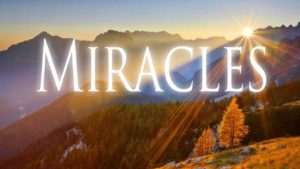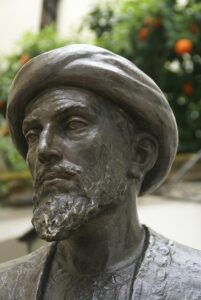Implications of the Miracles
Miracles performed by Jesus of Nazareth reported in the Gospels could demonstrate that Jesus is the Messiah, according to a Rabbi sage. At least one modern Jewish authority agrees with the accounts of miracles in the Gospels noting they define Jesus as a “miracle maker.”[1]

“…Matthew, Mark, and Luke present a reasonably faithful picture of Jesus as a Jew of his time. The picture of Jesus contained in them is not so much of a redeemer of mankind as of a Jewish miracle maker and preacher. The Jesus portrayed in these three Gospels is, therefore, the historical Jesus.” – Encyclopedia Judaica
Jewish sage Rabbi Maimonides authored Mishneh Torah circa 1180 AD. The work launched him into celebrity status causing a great response from the Jewish community who sent Maimonides fan letters with questions.[2] Maimonides’ responses to these letters are known as Responsa (Teshuvot).[3]
One question was posed by Rabbi Jacob al-Fayumi in reference to the Isaiah 52-53 parashah prophecy, known as the Epistle Concerning Yemen. Maimonides’ Responsa clarified his views about “the signs and wonders” that Isaiah prophesied would be performed by the Messiah:[4]
“…there shall rise up one of whom none have known before, and the signs and wonders which they shall see performed by him will be the proofs of his true origin…”
“…and so confounded at the wonders which they will see him work, that they will lay their hands to their mouth; in the words of Isaiah, when describing the manner in which the kings will hearken to him, At him kings will shut their mouth; for that which had not been told them have they seen, and that which they had not heard they have perceived.” – Rabbi Maimonides
Various reports of miracles, signs and wonders based on witness accounts are recounted by the authors of the Gospels. Some critics allege the Gospels are fictional books devised by Christian conspirators where restated miracles were used to make Jesus appear to be the Messiah.[5]
Comparing all four Gospels through literary analysis reveals a different story. Gospel accounts of miracles have less in common with each other than they have in common.
A total of 35 miracles are recorded before the crucifixion of Jesus, but only one is common to all four – the feeding of the 5000. One of the most famous miracles is Jesus walking on water and it does not even appear in Luke![6]
Less than a third of the miracles, only 10, are commonly recounted by the three Synoptic Gospels of Matthew, Mark and Luke. Nearly half of the 17 miracles performed before the crucifixion are uniquely detailed by a given Gospel author – 3 by Matthew, 2 by Mark, 6 by Luke and 6 by John.[7] Both instances of Jesus resurrecting the dead are exclusively narrated, one in Luke and another in John.[8]
Even with today’s standards of modern medicine, many of these bodily miracles cannot be duplicated: restoring a withered hand; restoring sight to a man born blind; and people raised from the dead.
All four Gospels contain accounts of Jewish religious leaders wanting retribution for Jesus when he performed miracles on the Sabbath. Ironically, Jewish leaders acknowledged miracles had occurred in order to criticize Jesus for performing them on the Sabbath.[9]
Detailed by all four Gospels, the greatest miracle story ever told is the unique self-resurrection from the dead by Jesus of Nazareth – the sole basis of Christianity. No credible evidence has ever been produced to debunk the miracle of the Resurrection.[10]
Often overlooked are the miracles, signs and wonders recounted after the Resurrection. Luke includes the eyewitness statement of Cleopas when the resurrected Jesus unknowingly appeared to him and his traveling partner on the road to Emmaus, sat down to dinner and prayed with them, then vanished before their eyes.[11]
Later that evening, Mark and Luke described when the resurrected Jesus suddenly appeared inside a locked room terrifying those present.[12] John exclusively reports it happened again 8 days later with Disciple Thomas present.[13]
John describes two more miracles that occurred days later at the Sea of Tiberius (Sea of Galilee).[14] Outside of the Gospels in the Book of Acts written by the author of the Gospel of Luke, Jesus rose in the sky and disappeared into a cloud.[15]
Acts author wrote that the miracles of Jesus of Nazareth attested to the fact that God was manifesting Himself through Jesus.[16] Quoting the Disciple Peter:
Act 2:22 “Men of Israel, hear these words: Jesus of Nazareth, a Man attested by God to you by miracles, wonders, and signs which God did through Him in your midst, as you yourselves also know ––” NKJV
Do miracles attest to the reality that Jesus of Nazareth was sent by God as the Messiah…and, if they do, what does that say about Gospels’ claim of the greatest and unique miracle, the Resurrection?
Updated October 17, 2023.
This work is licensed under a Creative Commons Attribution-NonCommercial-NoDerivatives 4.0 International License.
REFERENCES:
[1] “Jesus.” Encyclopaedia Judaica. p 246. CR “Jesus.” Encyclopedia.com. <https://www.encyclopedia.com/religion/encyclopedias-almanacs-transcripts-and-maps/jesus> “Miracles.” YouTube. photo. 2017. <https://i0.wp.com/theodds.website/wp-content/uploads/2018/05/Miracles-image.jpg?resize=300%2C169>
[2] Maimonides, Moses. Mishneh Torah. Moznaim Publications. Jewish year 4937 (1177 AD). Trans. Eliyahu Touger. Chabad.org. 2018. <https://www.chabad.org/library/article_cdo/aid/1188356/jewish/Melachim-uMilchamot-Chapter-11.htm> “Melachim uMilchamot.” Chabad.org. n.d. Chapter 11.3. <https://www.chabad.org/library/article_cdo/aid/1188356/jewish/Melachim-uMilchamot-Chapter-11.htm> Rich, Tracey R. “What Do Jews Believe?” Judaism101. 2011. <http://www.jewfaq.org/beliefs.htm>
[3] Mangel, Nissen. “Responsa.” Publisher: Kehot Publication Society. 2018. Chabad.org. 2014. <http://www.chabad.org/library/article_cdo/aid/107783/jewish/Responsa.htm>
[4] Isaiah 52:15. Maimonides .“Letter to the South (Yemen).” Neubauer and Driver. The Fifty-third Chapter of Isaiah According to the Jewish Interpreters. pp 374, 375. <https://books.google.com/books?id=YxdbAAAAQAAJ&pg=PP1#v=onepage&q=advent&f=false>
[5] Gloag, Paton J. Introduction to the Synoptic Gospels. pp vii-viii, 1-3. 1895. Online Books Page. Ockerbloom, ed. <http://catalog.hathitrust.org/Record/008728595> “Gospel Contradictions.” 2000. Walker, ed. PositiveAtheism.org. n.d. <https://web.archive.org/web/20150324003025/http://www.positiveatheism.org/mail/eml9449.htm> Smith, Ben C. “Gospel manuscripts – The manuscripts extant for the four canonical gospels.” TextExcavation.com. 2018. <http://www.textexcavation.com/gospelmanuscripts.html> Vick, Tristan D. “Dating the Gospels: Looking at the Historical Framework.” Advocatus Atheist. 2010. <http://advocatusatheist.blogspot.com/search?q=Dating+the+Gospels> “New Testament.” Jewish Encyclopedia. 2011. <http://www.jewishencyclopedia.com/articles/11498-new-testament> Etinger, Judah. Foolish Faith. Chapter 6. 2018. FoolishFaith.com. <http://www.foolishfaith.com/book_chap6_history.asp> Shamoun, Sam. “The New Testament Documents and the Historicity of the Resurrection.” Answering-Islam.org. 2018. <http://www.answering-islam.org/Shamoun/documents.htm>
[6] “The Miracles of Jesus.” Bible.org. 2018. <https://bible.org/series/miracles-jesus> Fairchild, Mary. “37 Miracles of Jesus.” ThoughtCo. 2017. <https://www.thoughtco.com/miracles-of-jesus-700158> Ryrie Study Bible. Ed. Ryrie Charles C. Trans. New American Standard. “The Story of Jesus.” “Part 13 –His Miracles of Nature.” n.d. Christian Classics Ethereal Library. <https://www.ccel.org/bible/phillips/CN171-MIRACLES.htm> “The Story of Jesus.” “Part 14 –His Healing Miracles.” n.d. Christian Classics Ethereal Library. <https://www.ccel.org/bible/phillips/CN175-HEALING.htm> “Gospel of John.” Theopedia.com. n.d. <https://www.theopedia.com/gospel-of-john>
[7] Fairchild. “37 Miracles of Jesus.” Ryrie. “The Miracles of Jesus.”
[8] Luke 7; John 4.
[9] Matthew 12; Mark 3; Luke 6, 13; John 5, 9.
[10] Matthew 28; Mark 16; Luke 24; John 20; I Corinthians 15. Strobel, Lee. The Case For Christ. 1998. Part 3.
[11] Luke 24; CR Mark 16.
[12] Mark 16; Luke 24. NET.
[13] John 20. NRSV.
[14] John 16. “Gospel of John.” Theopedia.com. “The Book of John.” Quartz Hill School of Theology. n.d. <http://www.theology.edu/biblesurvey/john.htm> Smith, Barry D. “The Gospel of John.” Crandall University. 2015. <http://www.mycrandall.ca/courses/NTIntro/John.htm>
[15] Acts 1.
[16] Acts 1:3, 15; I Corinthians 15. Irenaeus of Lyons. Against Heresies. Philip Schaf, ed. Ante-Nicene Fathers. Volume I. Book III, Chapter XIV.1. Christian Classics Ethereal Library. 2005. <http://www.ccel.org/search/fulltext/Heresies> Aherne, Cornelius. “Gospel of Saint Luke.” The Catholic Encyclopedia. Volume 9. 1910. New Advent. 2015. <http://www.newadvent.org/cathen/09420a.htm> Cline, Austin. “Luke the Evangelist: Profile & Biography of Luke.” About.com|Agnosticism/Atheism. n.d. <http://atheism.about.com/od/biblepeoplenewtestament/p/LukeEvangelist.htm> Singer, Isidore; Adler, Cyrus, et. al. The Jewish Encyclopedia. Volume 9. “Luke.” pp 251. 1912. <http://books.google.com/books?id=lfoOtGOcIBYC&lpg=PA594&ots=6qoCfVVUz7&dq=wave%20sheaf%20encyclopedia&pg=PA594#v=onepage&q&f=false>


